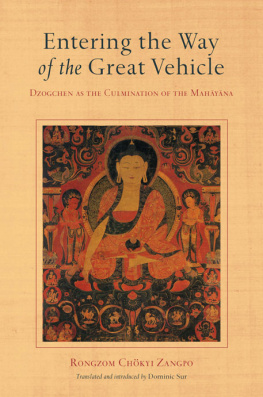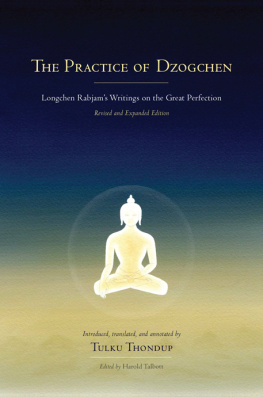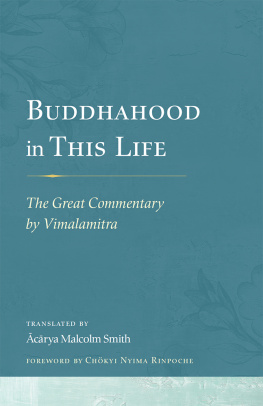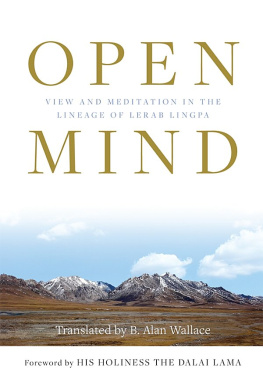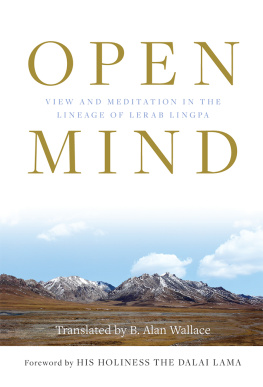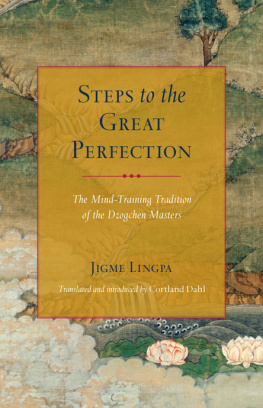Sign up to receive news and special offers from Shambhala Publications.

Or visit us online to sign up at shambhala.com/eshambhala.
Entering the Way of the Great Vehicle

Dzogchen as the Culmination of the Mahyna
Rongzom Chkyi Zangpo
TRANSLATED AND INTRODUCED BY
Dominic Sur

Snow Lion
An imprint of Shambhala Publications, Inc.
4720 Walnut Street
Boulder, Colorado 80301
www.shambhala.com
Cover art: Shakyamuni Buddha with Two Bodhisattvas, Thirty-Five Buddhas of Confession, and Seventeen Arhats, Tibet, 14501500. Virginia Museum of Fine Arts, Richmond. Nasli and Alice Heermaneck Collection. Gift of Paul Mellon. Photo by Travis Fullerton. Virginia Museum of Fine Arts.
2017 by Dominic Sur
All rights reserved. No part of this book may be reproduced in any form or by any means, electronic or mechanical, including photocopying, recording, or by any information storage and retrieval system, without permission in writing from the publisher.
Library of Congress Cataloging-in-Publication Data
Names: Rong-zom Chos-kyi-bzang-po, 10121088, author. | Sur, Dominic, translator.
Title: Entering the way of the great vehicle: dzogchen as the culmination of the Mahyna / Rongzom Chkyi Zangpo; translated and introduced by Dominic Sur.
Other titles: Theg pa chen poi tshul la jug pa. English
Description: First edition. | Boulder: Snow Lion, 2017. | Includes bibliographical references and index. | Translated from Tibetan.
Identifiers: LCCN 2016019345 | eISBN 9780834840454 | ISBN 9781611803686 (hardback: alk. paper)
Subjects: LCSH: Rdzogs-chenEarly works to 1800. | Mahayana BuddhismDoctrinesEarly works to 1800. | BISAC: RELIGION / Buddhism / Tibetan. | RELIGION / Buddhism / Sacred Writings.
Classification: LCC BQ7662.4 .R6613 2017 | DDC 294.3/420423dc23
LC record available at https://lccn.loc.gov/2016019345

This book contains diacritics and special characters. If you encounter difficulty displaying these characters, please set your e-reader device to publisher defaults (if available) or to an alternate font.

THE STORY OF my involvement with Rongzom begins with James Gentry, who introduced me to Rongzom in the fall of 2009 and suggested that I might be interested in Entering the Way of the Great Vehicle. I am very grateful for all the help and encouragement James has given me, before and since. His example of Tibetological scholarship has been an inspiration. Before that time, and since, many other people have also assisted and collaborated with me and I would like to thank several in particular.
First, Id like to thank my parents, especially my mom, Maggiewho never quit on me. And I would like to thank the Di Zinno and Sur families for the support theyve offered over the years.
Within the Tibetan Buddhist tradition, I would like to thank my first teacher, Khenpo Lama Chnam of Golog, a scholar, poet, and practitioner for whom I have the deepest admiration. Also, let me offer my sincere gratitude to some of the many people who gave their time and assistance to this project: Matthieu Ricard introduced me to Khensur Tsering Dorji Rinpoche, who transmitted Entering the Way to me and answered many questions. Khenpo Sangye Phuntshog and my good friend, the Venerable Gelong Tenzin Jamchen (Lama Sean Price) of Shechen monastery, were also very generous with their time and erudition. The Venerable Sean, in particular, has been very generous and deserves my thanks. I must also thank Pema Tharchin Rinpoche and Khenpo Gaden of Serlo Monastery for their hospitality and much-needed help in translation. I must also express gratitude for the help of Sogan Rinpoche (Tulku Pema Lodoe of Golog). I also owe many profound thanks to Khenpo Tsultrim Lodoe and Tenzin Gyatso of Serta Larung Gar monastery, for taking time to answer my questions about Rongzompas Entering the Way. Additionally, Khenpo Nawang Jorden of the Sakya International Buddhist Academy, Geshe Tashi Dhondup, and Lama Kunkhen of Kopan Monastery deserve my thanks. My old friend Geshema Namdrol Phuntsog, of Kopan Nunnery, was also generous with her time and erudition.
Within academia, I must thank David Germano, my primary academic advisor at the University of Virginia. The time and advice he has given me in both personal and professional terms has been invaluable. In my time at UVA, David has time and again gone out of his way to helpand I am thankful to him for it. I would also like to express my gratitude to several other teachers at the University of Virginia: Karen Lang and Kurtis Schaeffer. I would also like to express my gratitude to several scholars who helped me while I was studying at Harvard Divinity School: Leonard van der Kuijp, Charles Hallisey, and Janet Gyatso each deserve thanks. A number of other scholarsJos Cabezn, Orna Almogi, Dorji Wangchuk, Andy Francis, Douglas Duckworth, David Higgins, William McGrath, and Michael Sheehyalso deserve my thanks, as do Ravi Gupta, Tammy Proctor, and all my colleagues in the Department of History at Utah State University.
Much of the work that made this translation possible was accomplished while on a Fulbright-IIE grant to Nepal (20122013), which I was grateful and honored to receive.
I also want to extend my thanks to my oldest friend, Jayme Burtis, the Bridges family, and Richard Josephson. These people, precious longtime family and friends, have supported me through many years of study. Without their support and encouragement, my life, which I am immensely grateful for, would look nothing like it does now.
Thanks is certainly owed to the folks at Shambhala Publications, Nikko Odiseos and Michael Wakoff, in particular. My thanks for their patience and expertise in bringing this wonderful text to print.
Whatever value there is in this translation, it comes about as the consequence of my collaborations with others. Whatever flaws there are herein are mine alone. And while my translation of Rongzompas Entering the Way of the Great Vehicle may be the first for the English-speaking world, it most certainly will not be the last. As such, I can only hope that this first effort supports further explorations and a more refined understanding of Rongzom, Entering the Way of the Great Vehicle, and Himalayan Buddhisms intellectual history and culture.

Finally, I am incredibly fortunate to have a partner, Me Sur, who enriches my life and, during the course of this project, picked me up and dusted me off through many ups and downs.
June 2016, Idyllwild, CA

THE THIRD CHAPTER of The Blue Annals, These men thought it unacceptable that a person born in Tibet, like Rongzom, had composed such a large number of commentarial and scholastic treatises (
Next page
